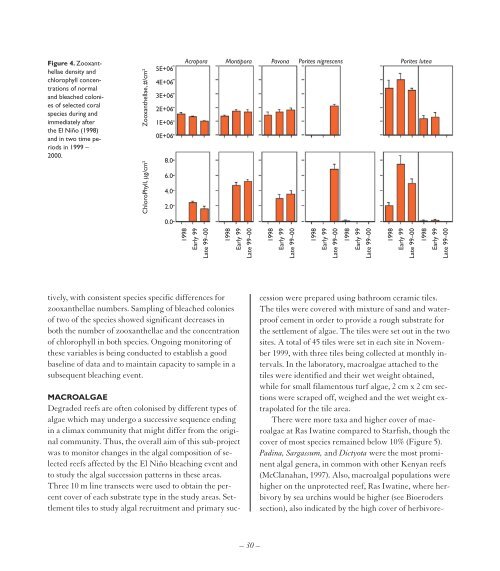Create successful ePaper yourself
Turn your PDF publications into a flip-book with our unique Google optimized e-Paper software.
Figure 4. Zooxanthellae<br />
density and<br />
chlorophyll concentrations<br />
of normal<br />
and bleached colonies<br />
of selected coral<br />
species during and<br />
immediately after<br />
the El Niño (1998)<br />
and in two time periods<br />
in 1999 –<br />
<strong>2000</strong>.<br />
ChloroPhyll, µg/cm 2 Zooxanthellae, #/cm 2<br />
5E+06<br />
4E+06<br />
3E+06<br />
2E+06<br />
1E+06<br />
0E+06<br />
8.0<br />
6.0<br />
4.0<br />
2.0<br />
Acropora Montipora Pavona Porites nigrescens Porites lutea<br />
0.0<br />
1998<br />
Early 99<br />
Late 99–00<br />
1998<br />
Early 99<br />
Late 99–00<br />
1998<br />
Early 99<br />
Late 99–00<br />
1998<br />
Early 99<br />
Late 99–00<br />
1998<br />
Early 99<br />
Late 99–00<br />
1998<br />
Early 99<br />
Late 99–00<br />
1998<br />
Early 99<br />
Late 99–00<br />
tively, with consistent species specific differences for<br />
zooxanthellae numbers. Sampling of bleached colonies<br />
of two of the species showed significant decreases in<br />
both the number of zooxanthellae and the concentration<br />
of chlorophyll in both species. Ongoing monitoring of<br />
these variables is being conducted to establish a good<br />
baseline of data and to maintain capacity to sample in a<br />
subsequent bleaching event.<br />
MACROALGAE<br />
Degraded reefs are often colonised by different types of<br />
algae which may undergo a successive sequence ending<br />
in a climax community that might differ from the original<br />
community. Thus, the overall aim of this sub-project<br />
was to monitor changes in the algal composition of selected<br />
reefs affected by the El Niño bleaching event and<br />
to study the algal succession patterns in these areas.<br />
Three 10 m line transects were used to obtain the percent<br />
cover of each substrate type in the study areas. Settlement<br />
tiles to study algal recruitment and primary succession<br />
were prepared using bathroom ceramic tiles.<br />
The tiles were covered with mixture of sand and waterproof<br />
cement in order to provide a rough substrate for<br />
the settlement of algae. The tiles were set out in the two<br />
sites. A total of 45 tiles were set in each site in November<br />
1999, with three tiles being collected at monthly intervals.<br />
In the laboratory, macroalgae attached to the<br />
tiles were identified and their wet weight obtained,<br />
while for small filamentous turf algae, 2 cm x 2 cm sections<br />
were scraped off, weighed and the wet weight extrapolated<br />
for the tile area.<br />
There were more taxa and higher cover of macroalgae<br />
at Ras Iwatine compared to Starfish, though the<br />
cover of most species remained below 10% (Figure 5).<br />
Padina, Sargassum, and Dictyota were the most prominent<br />
algal genera, in common with other Kenyan reefs<br />
(McClanahan, 1997). Also, macroalgal populations were<br />
higher on the unprotected reef, Ras Iwatine, where herbivory<br />
by sea urchins would be higher (see Bioeroders<br />
section), also indicated by the high cover of herbivore-<br />
– 30 –


















